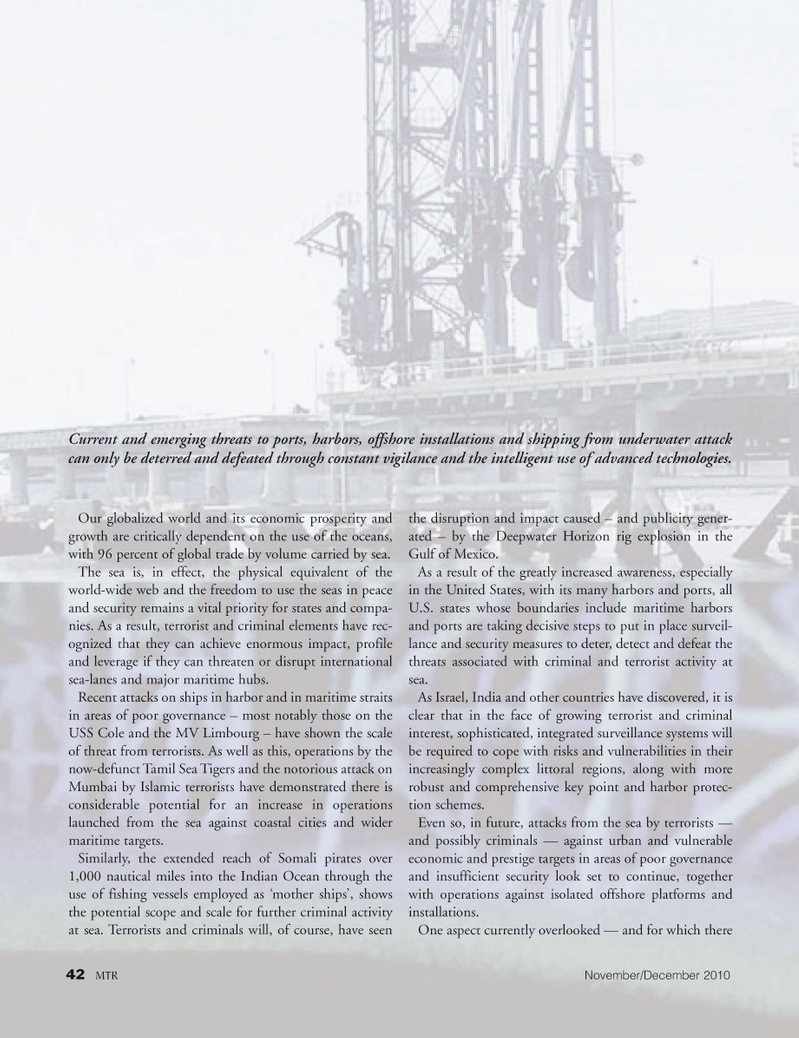
Page 42: of Marine Technology Magazine (November 2010)
Fresh Water Monitoring and Sensors(lakes, rivers, reservoirs)
Read this page in Pdf, Flash or Html5 edition of November 2010 Marine Technology Magazine
42 MTR November/December 2010
Current and emerging threats to ports, harbors, offshore installations and shipping from underwater attack can only be deterred and defeated through constant vigilance and the intelligent use of advanced technologies.
Our globalized world and its economic prosperity and growth are critically dependent on the use of the oceans, with 96 percent of global trade by volume carried by sea.
The sea is, in effect, the physical equivalent of the world-wide web and the freedom to use the seas in peace and security remains a vital priority for states and compa- nies. As a result, terrorist and criminal elements have rec- ognized that they can achieve enormous impact, profile and leverage if they can threaten or disrupt international sea-lanes and major maritime hubs.
Recent attacks on ships in harbor and in maritime straits in areas of poor governance – most notably those on the
USS Cole and the MV Limbourg – have shown the scale of threat from terrorists. As well as this, operations by the now-defunct Tamil Sea Tigers and the notorious attack on
Mumbai by Islamic terrorists have demonstrated there is considerable potential for an increase in operations launched from the sea against coastal cities and wider maritime targets.
Similarly, the extended reach of Somali pirates over 1,000 nautical miles into the Indian Ocean through the use of fishing vessels employed as ‘mother ships’, shows the potential scope and scale for further criminal activity at sea. Terrorists and criminals will, of course, have seen the disruption and impact caused – and publicity gener- ated – by the Deepwater Horizon rig explosion in the
Gulf of Mexico.
As a result of the greatly increased awareness, especially in the United States, with its many harbors and ports, all
U.S. states whose boundaries include maritime harbors and ports are taking decisive steps to put in place surveil- lance and security measures to deter, detect and defeat the threats associated with criminal and terrorist activity at sea.
As Israel, India and other countries have discovered, it is clear that in the face of growing terrorist and criminal interest, sophisticated, integrated surveillance systems will be required to cope with risks and vulnerabilities in their increasingly complex littoral regions, along with more robust and comprehensive key point and harbor protec- tion schemes.
Even so, in future, attacks from the sea by terrorists — and possibly criminals — against urban and vulnerable economic and prestige targets in areas of poor governance and insufficient security look set to continue, together with operations against isolated offshore platforms and installations.
One aspect currently overlooked — and for which there

 41
41

 43
43
